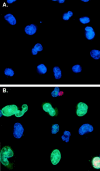Evidence that dynamin-2 functions as a signal-transducing GTPase
- PMID: 10893263
- PMCID: PMC2185575
- DOI: 10.1083/jcb.150.1.145
Evidence that dynamin-2 functions as a signal-transducing GTPase
Abstract
The role of dynamin GTPases in the regulation of receptor-mediated endocytosis is well established. Here, we present new evidence that the ubiquitously expressed isoform dynamin-2 (dyn2) can also function in a signal transduction pathway(s). A </=5-fold increase of dyn2 relative to endogenous levels activates the transcription factor p53 and induces apoptosis, as demonstrated by reduced cell proliferation, DNA fragmentation, and caspase-3 activation. Dyn2-triggered apoptosis occurs only in dividing cells and is p53 dependent. A mutant defective in GTP binding does not trigger apoptosis, indicating that increased levels of dyn2.GTP, rather than protein levels per se, are required to transduce signals that activate p53. A truncated dyn2 lacking the COOH-terminal proline/arginine-rich domain (PRD), which interacts with many SH3 domain-containing partners implicated in both endocytosis and signal transduction, triggers apoptosis even more potently than the wild-type. This observation provides additional support for the importance of the NH(2)-terminal GTPase domain for the apoptotic phenotype. All described effects are dyn2-specific because >200-fold overexpression of dyn1, the 70% identical neuronal isoform, has no effect. Our data suggest that dyn2 can act as a signal transducing GTPase affecting transcriptional regulation.
Figures










Similar articles
-
Redundant and distinct functions for dynamin-1 and dynamin-2 isoforms.J Cell Biol. 1998 Dec 28;143(7):1871-81. doi: 10.1083/jcb.143.7.1871. J Cell Biol. 1998. PMID: 9864361 Free PMC article.
-
Early and nonredundant functions of dynamin isoforms in clathrin-mediated endocytosis.Mol Biol Cell. 2020 Aug 15;31(18):2035-2047. doi: 10.1091/mbc.E20-06-0363. Epub 2020 Jun 24. Mol Biol Cell. 2020. PMID: 32579424 Free PMC article.
-
Ubiquitously expressed dynamin-II has a higher intrinsic GTPase activity and a greater propensity for self-assembly than neuronal dynamin-I.Mol Biol Cell. 1997 Dec;8(12):2553-62. doi: 10.1091/mbc.8.12.2553. Mol Biol Cell. 1997. PMID: 9398675 Free PMC article.
-
Dynamin, endocytosis and intracellular signalling (review).Mol Membr Biol. 1996 Oct-Dec;13(4):189-215. doi: 10.3109/09687689609160598. Mol Membr Biol. 1996. PMID: 9116759 Review.
-
The role of the PH domain and SH3 binding domains in dynamin function.Cell Signal. 1997 Sep;9(6):395-401. doi: 10.1016/s0898-6568(97)00041-7. Cell Signal. 1997. PMID: 9376220 Review.
Cited by
-
Amyloidogenic processing of the Alzheimer beta-amyloid precursor protein depends on lipid rafts.J Cell Biol. 2003 Jan 6;160(1):113-23. doi: 10.1083/jcb.200207113. Epub 2003 Jan 6. J Cell Biol. 2003. PMID: 12515826 Free PMC article.
-
Actin and dynamin2 dynamics and interplay during clathrin-mediated endocytosis.J Cell Biol. 2014 Jun 9;205(5):721-35. doi: 10.1083/jcb.201403041. Epub 2014 Jun 2. J Cell Biol. 2014. PMID: 24891602 Free PMC article.
-
Modulation of Rac localization and function by dynamin.Mol Biol Cell. 2004 Jan;15(1):256-67. doi: 10.1091/mbc.e03-01-0019. Epub 2003 Nov 14. Mol Biol Cell. 2004. PMID: 14617821 Free PMC article.
-
Regulation of dynamin family proteins by post-translational modifications.J Biosci. 2017 Jun;42(2):333-344. doi: 10.1007/s12038-017-9680-y. J Biosci. 2017. PMID: 28569256 Review.
-
Fibronectin matrix turnover occurs through a caveolin-1-dependent process.Mol Biol Cell. 2005 Feb;16(2):757-68. doi: 10.1091/mbc.e04-08-0672. Epub 2004 Nov 24. Mol Biol Cell. 2005. PMID: 15563605 Free PMC article.
References
-
- Ahn S., Maudsley S., Luttrell L.M., Lefkowitz R.J., Daaka Y. Src-mediated tyrosine phosphorylation of dynamin is required for beta2-adrenergic receptor internalization and mitogen-activated protein kinase signaling. J. Biol. Chem. 1999;274:1185–1188. - PubMed
-
- Behl C., Davis J.B., Lesley R., Schubert D. Hydrogen peroxide mediates amyloid beta protein toxicity. Cell. 1994;77:817–827. - PubMed
-
- Blagosklonny M.V. Loss of function and p53 protein stabilization. Oncogene. 1997;15:1889–1893. - PubMed
-
- Budihardjo I., Holt O., Lutter M., Luo X., Wang X. Biochemical pathways of caspase activation during apoptosis. Annu. Rev. Cell Dev. Biol. 1999;15:269–290. - PubMed
Publication types
MeSH terms
Substances
Grants and funding
LinkOut - more resources
Full Text Sources
Molecular Biology Databases
Research Materials
Miscellaneous

